Each legion included a body of professional engineers, workers, craftsmen or artisans (called fabri) for siege work and the construction of bridges, roads, fortifications and other projects, placed under an officer called thepraefectus fabrum. Fortification construction was the responsibility of special engineering units to which specialists of many types belonged, officered by architecti (architects and engineers) and men-sores (surveyors), from a class of troops known as immunes since they were excused from regular duties. These engineers might requisition manual labor from the soldiers at large as needed, and therefore each Roman legionary was equipped with a dolabra (pickaxe), and a pala (spade), alongside his gladius (sword) and pilum (javelin). Other specialized trades included the hydraularius (responsible for water supply and drainage), the naupegus (shipwright), ballistarius (catapult maker and artilleryman), specularius (glazier), sagittarius (arrow maker), and several others like the woodsmen in charge of tree felling, for example. Roman military engineering fulfilled both routine and extraordinary roles, the former a standard military defensive procedure, and the latter the offensive nature of siege warfare.
A legion’s engineer unit could throw up a camp in as little as a few hours. Judging from the names, they probably used a repertory of camp plans from a set text-
Book, selecting the one appropriate to the strength and length of time a unit would spend in it, e. g., tertia castra (a camp for three days), quarta castra (camp for four days). In wartime Roman engineers designed, built and operated siege machines. Although most Roman siege engines were adaptations from earlier Greek designs, the Romans were adept at engineering them swiftly and efficiently, as well as innovating variations such as the onager. Owing to knowledge and experience gained through routine peacetime and civilian engineering they also developed siege techniques. One of the most famous of such extraordinary constructions was the circum-vallation of the entire oppidum of Alesia, defended by the Gallic leader Vercingetorix in 52 B. C., within a massive length of double-wall — one inward-facing to prevent escape or offensive sallies from the city, and one outward-facing to prevent attack by Celtic reinforcements. This wall was estimated to be over 13 miles (20 km) long. Another successful example would be the large circumvallation and massive 30 feet (9.1 m) assault ramp built at the seige of Massada (Palestine) during the Jewish Revolt in 72-73. It was constructed by order of Luvius Flavius on a natural spur of bedrock and used tons of stones and beaten earth. The ramp went up to the invested city of Masada (Palestine) in the Jewish Revolt in 72-73.
Roman siege works in Britain are scant, and issues concerning Roman attacks on Celtic hill forts are still disputed today. Finds at Maiden Castle and Hod Hill in Dorset, southern England, suggest siege being laid to these Celtic hill forts. At Brunswark in southern Scotland, archaeological evidence has revealed the existence of two Roman siege camps, but scholars now think they were training camps intended for practicing mock attacks and simulating siege techniques. Archaeologists are still debating whether the Roman siege works dug near the hill fort of Woden Law, Roxburgh, in Scotland were actually used to lay siege or rather served as a training ground just like Brunswark.
The Roman engineer corps also built roads and bridges. When invading enemy territories, and later when countries were conquered, the Roman army would improve or create means of communication in order to allow swift reinforcement and resupply, as well as a path for easy retreat if necessary. Roman road-making skills were such that some Roman roads survive to this day. Bridges were made from both timber and stone depending on required permanence and time available. Stone bridges were made possible by the innovative use of the keystone to allow an arch construction, and some have come down to us. An excellent example of a remarkable masterwork of engineering is the Alcantara Bridge located near the city of Alcantara (in Arabic “bridge”) in western Spain (province of Caceres) near the border with Portugal. Still existing today, it was built between a. d. 104 and 106, under Emperor Trajan. Other remarkable engineering works were, for example, the road built in the Petit-Saint-Bernard pass in the Alps between Gaul and the Aosta Valley in northern Italy, as well as the 900-meter-long tunnel designed by engineer Lucius Coccelus Auctus and dug during the reign of Augustus under the Monte Grillo Ridge between Baies and Cumes in Italy.
The Roman army was also involved in building projects for civilian use such as the construction of town walls, the digging of shipping canals, aqueducts,
And harbors, the drainage of land, even the cultivation of vineyards. In some cases soldiers were even used in mining work, prospecting for metal veins, operating dewatering machines, and building reservoirs to hold the water at the minehead.
There were sound reasons for using the army in both military and civilian building projects. Primarily, when they were not directly engaged in military campaigns, the legions were largely unproductive, costing the Roman state large sums of money. Besides, the involvement of soldiers in building works kept them not only well accustomed to hard physical labor, but also busy, since it was well understood that idleness could undermine discipline. Roads and bridges as well as permanent fortifications and other civilian buildings had the additional advantage of impressing the conquered people, who had little experience with engineering, to emphasize the superiority of Roman culture, and to display the conqueror’s power and glory.
(Continued on page 62.)
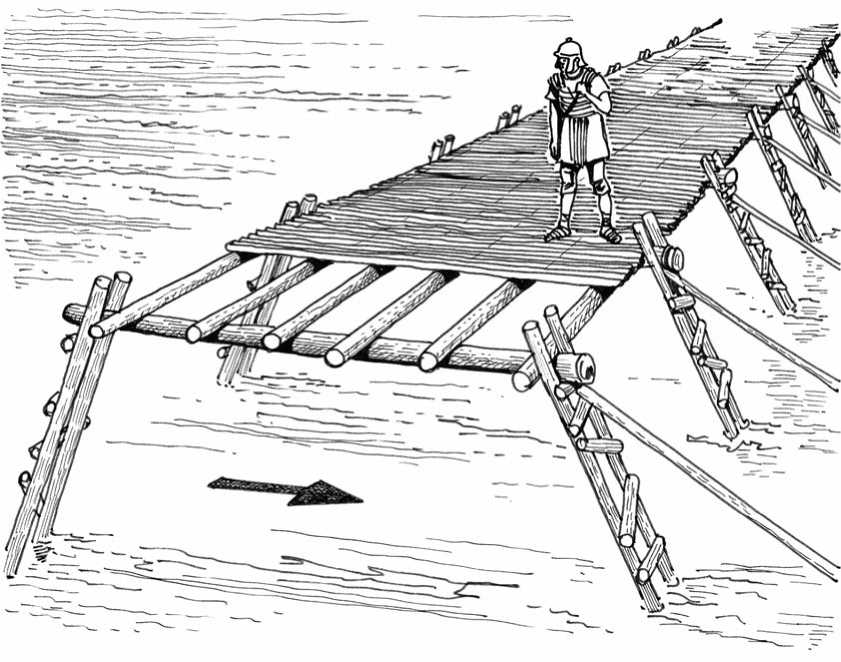
Caesar’s bridge across the Rhine. The first two bridges to cross the Rhine River were built by Julius Caesar and his legionaries during the Gallic War in 55 b. c. and 53 b. c. Strategically successful, they were considered masterpieces of military field engineering. Caesar’s first bridge was most likely erected between Andernach and Neuwied, downstream of Koblenz. Two years later, close to the site of the first bridge, possibly at today’s Urmitz (near Neuwied), Caesar ordered the construction of a second bridge.
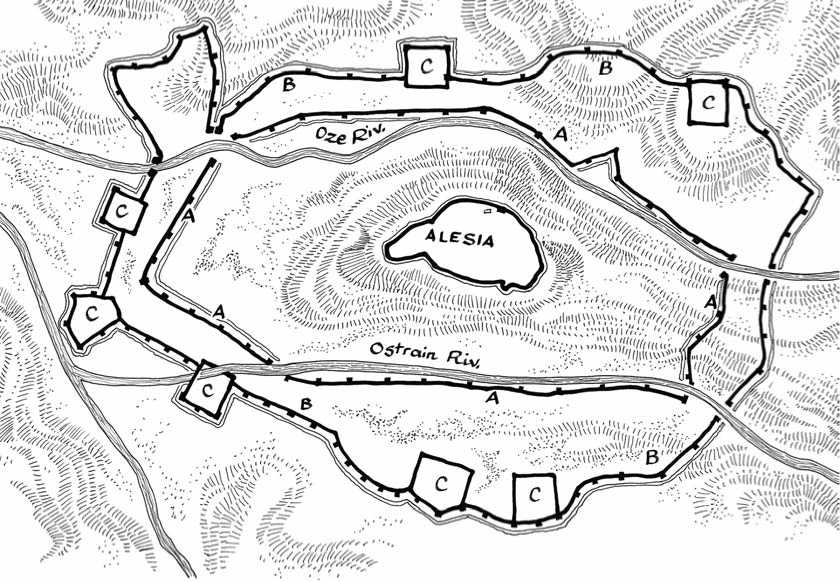
Siege of Alesia, 52 b. c. The siege of the major Gallic oppidum of Alesia led by Julius Caesar (and described in his commentaries on the war in Gaul, book VII, chapters 63-90) took place in late 52 b. c. It marked the turning point of the Gallic Wars in favor of Rome. The siege is considered one of Caesar’s greatest military achievements, and is still one of the classic examples of siege warfare. Alesia was probably situated atop Mont Auxois, above modern Alise-Sainte-Reine in France, but this location is still disputed. An alternative would be Chaux-des-Crotenay (in the Jura Mountains). As the Romans were outnumbered by five to one by a coalition of Gallic tribes commanded by the leader Vercingetorix, Caesar ordered the construction of an encircling set of fortifications, or circumvallation, around Alesia in order to blockade the Gallic force. The cir-cumvallation was about 18 kilometers in length, and consisted of a 4-meter-high earth wall and two 4.5-meter-wide ditches, about 1.5 m deep, and regularly spaced timber watchtowers equipped with artillery. These fortifications were supplemented with mantraps and obstacles in front of and in the ditches, creating a dangerous killing zone. Anticipating that a relief force of258,000 would be sent to release the besieged, Caesar ordered the construction of a second line of fortifications, the contravallation, facing outward. The second line, intended to protect the besiegers, was identical to the first in design and extended for 20 km, including infantry and cavalry camps. Although the Gauls launched massive attacks, the Romans, well entrenched in their field fortifications, ultimately could both repulse the relief army and obtain the surrender of Vercingetorix by starving his troops. A: Countervallation; B: Circumvallation; C: Roman infantry and cavalry camps.
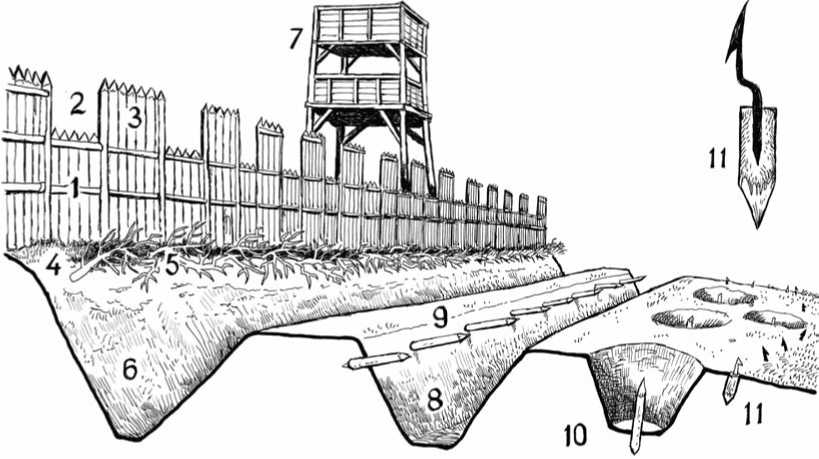
Top: Cross-section of the Roman fieldworks at Alesia: 1: Lorica (parapet) made of palisade poles; 2: Pinna (crenel or void); 3: Merlon (upstanding solid sections of a parapet between the crenels, behind which the defenders could shelter); 4: Vallum or agger (earth wall); 5: Cervi (sharpened tree branches acting as obstacle); 6: Fossa (ditch) 7: Turris (tower with artillery); 8: Second ditch; 9: Cippe (sharp poles); 10: Lilium (wolf’s pit-concealed interlocking conical excavations about 2 meters in diameter and 2.5 meters deep in which one or more dangerous sharpened stakes or spikes were placed); 11: Stimulus (a sharp barbed iron hook fixed on a short stake stuck in the ground, concealed in grass and planted in great number around a position, intended to injure attacking enemy infantrymen and horses).
Bottom: Kantara bridge (Algeria). The Roman bridge near the village of Kantara (called in Roman time Calceus Herculis) in Algeria, halfway between Biskra and Batna in the Aures Mountains, still exists today.
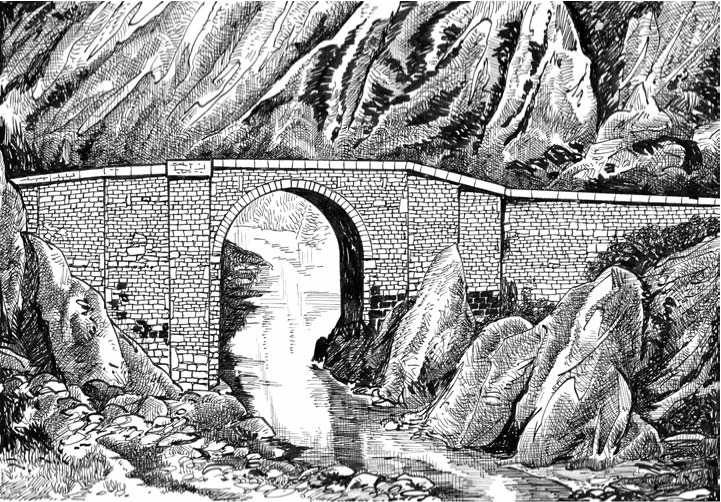
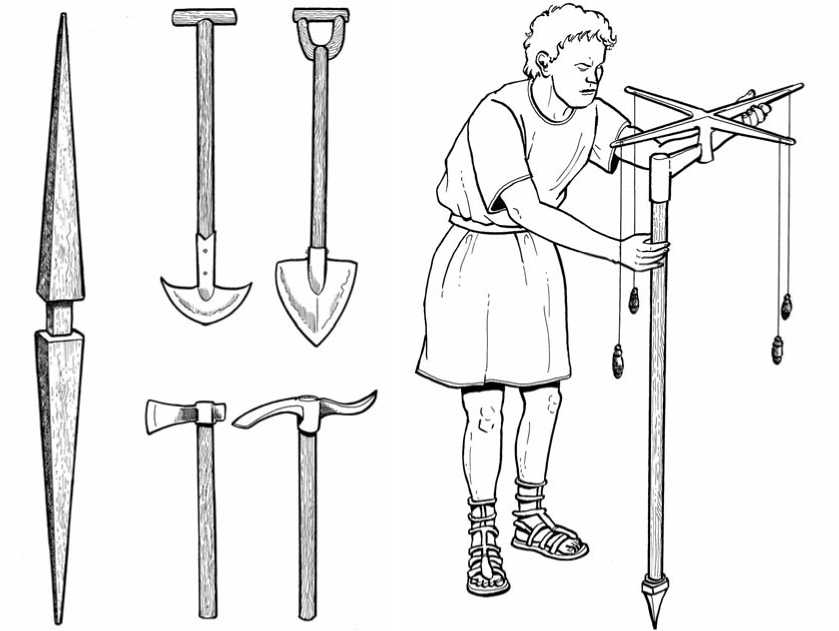
Left: Tools. The sudis (plural sudes) was the name given to a stake, pictured to the left, carried by Roman legionaries for employment as a field fortification. Each stake was made of hardwood, usually oak, about 150-180 cm (5-6 feet) long and about 50-100 mm (2-4 in) wide at the thickest point. Square in section, the shape tapered to a point at both ends. The central part was narrowed in a way that suggests the function of a handle, or to facilitate lashing—although this remains unclear. The actual purpose might have been that sudes were used to form a temporary defense, a barrier and incorporated into the ramparts of a Roman marching castrum. It is also believed that sudes lashed in pairs at intervals along a log or beam could form a sort of moveable frizzy horse.1 Alternatively, three sudes might have been roped together into a sort of anticavalry obstacle—in modern parlance a Czech hedgehog. Engineering tools included spades, pollaxes, and pick-axes.
Right: The groma was one of the principal Roman surveying instruments. It comprised a vertical staff with horizontal cross pieces mounted at right angles on a bracket. Each crosspiece had a plumb line hanging vertically at each end. It was used by engineers and architects to survey straight lines and right angles, thence squares or rectangles, and to trace on the ground simple and orthogonal alignments, necessary to the construction of camps, roads, cities, temples and agricultural land subdivisions.
Roman pentaspastos. During the Roman Empire construction activity soared and buildings reached enormous dimensions. The Romans adopted the Greek crane and developed it further. The simplest Roman crane, the trispastos, consisted of a single-beam jib, a winch, a rope, and a block containing three pulleys. It has been calculated that a single man working the winch could raise 150 kg.

Heavier crane types featured five pulleys (pentaspastos) or, in the case of the largest one, a set of three by five pulleys (polyspastos), and came with two, three or four masts, depending on the maximum load. The polyspastos, when worked by four men at both sides of the winch, could lift up to 3,000 kg.
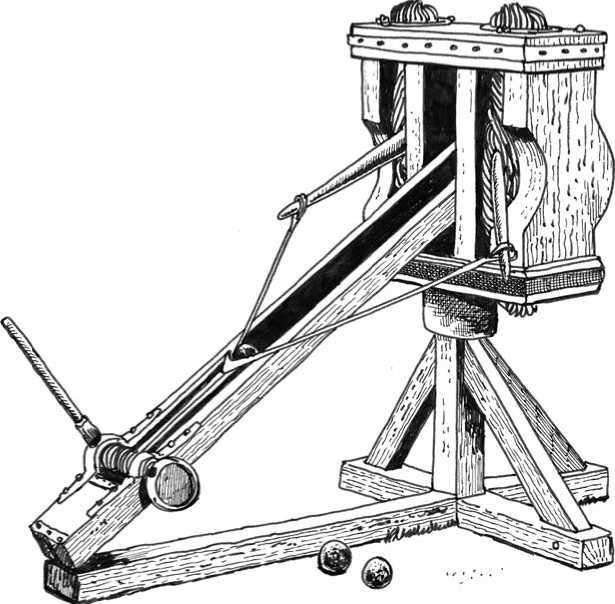
The Roman ballista was a throwing machine powered by torsion derived from two thick skeins of twisted cords through which were thrust two separate arms joined at their ends by the cord that propelled the missile. The largest could accurately hurl a stone ball weighing some 60 lb (27 kg) up to about 500 yards (450 m.)




 World History
World History



![The General Who Never Lost a Battle [History of the Second World War 29]](https://www.worldhistory.biz/uploads/posts/2015-05/1432581983_1425486253_part-29.jpeg)





